A TASTE OF THE ORIENT PART 3: RAFFETY GOES EAST
February 13th 2014
For those of our dedicated followers who read our blog and contact us through the company website, you may have noticed under ‘News and events’ a logo, Design Shanghai. If you let your curiosity go a little further you may have read that Raffety Ltd are participating in an exciting new adventure and is exhibiting at a Contemporary Design, Fine Arts and Antiques fair in one of Asia’s most exciting and most cosmopolitan of cities. Before I go any further though with a description of some of the pieces that we hope may tempt the established Chinese collectors which will be on display at the fair, we thought it may be fun to take a quick glimpse at what our friendly Mr Raffety will be enjoying in this colourful part of the world.
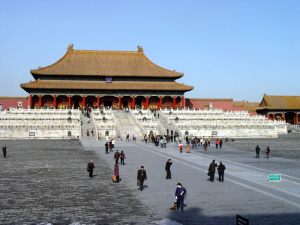
The Forbidden City, Beijing.
China must be the most amazing of places. For one thing you have Beijing and the beautiful Forbidden City. In the 18th century the Emperors of China collected clocks and at the Imperial Museum there is a whole colourful collection of musical and automata clocks on display. There is also the famous Great Wall and the Terracotta Army which can thrill and delight.
On the other side of the Chinese coin, Shanghai, the place where Mr Raffety is visiting after Beijing is a melting pot known as ‘The Pearl of the Orient’ or ‘The Paris of the East’. For those of our followers who have never been there, you may know the city in films, such as ‘Shanghai Express’, ‘Empire of the Sun’, ‘The Red Violin’ and ‘Purple Butterfly’. With a population of twenty-four million Shanghai is one of China’s largest cities. It is the country’s financial centre and has the world’s busiest container port. The city sits at the mouth of the Yangtze River in the middle of the Chinese coast.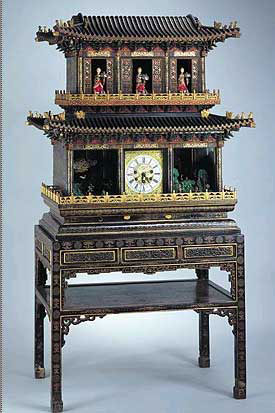
A Magnificent Automaton Clock, with English Clock Movement, in the Forbidden City Museum, Beijing.
The name Shanghai derives from the word ‘Shang’ meaning, ‘above’ and ‘Hai’ mean’s ‘Sea’, together meaning ‘Upon-the -Sea’. The earliest settlement dates from the 11th century where there was a town with this name in the area. Historians today have concluded that during the Tang dynasty Shanghai was literally on the sea, so hence the origin of the name.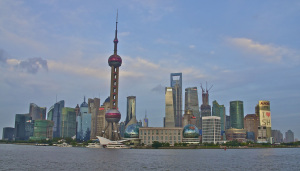
Modern Shanghai
For centuries the capital was known for its shipping, administration and for trading. Europeans were attracted to the city when it was opened for foreign trade after British victory over China in the first Opium war. In 1842 the treaty of Nanking allowed the establishment of the Shanghai International Settlement. This vibrant city flourished throughout the 19th and 20th centuries until 1949 when the communists took over, by which time the cities global influence had declined. By the 1990’s the future was looking brighter for Shanghai with reforms by Deng Xiaoping which resulted in reinvestment and redevelopment transformed the city, bringing encouragement for European investment and commerce to Shanghai.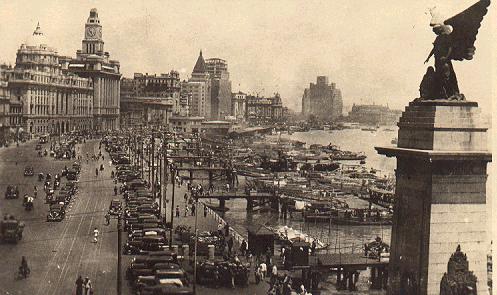 Old Shanghai and the Bund.
Old Shanghai and the Bund.
Shanghai has the most amazing cityscape. It is almost something out of a science fiction film. For dazzling architecture you may see the huge Jinmao Tower, visit Yuguan Gardens and bazaar, Huzhou pagoda, and take a stroll around the back alley communities of Nontango. For museum culture you can look no further than Shanghai Museum of Art and History, the China Art Museum or the Shanghai Natural History Museum to name but a few. If Design Shanghai has exhausted you then take the road to Nanjing Lu which is the down town Shanghai shopping district where you will feel quite at home with all the gorgeous glossy brands that you see in the West.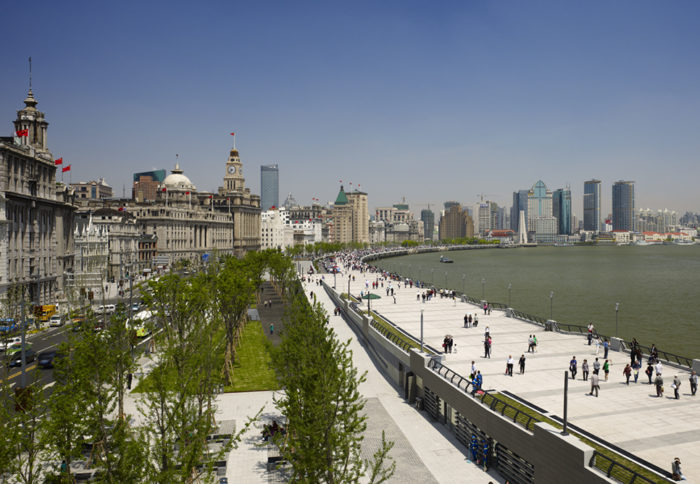 The Famous Bund in Shanghai.
The Famous Bund in Shanghai.
Other than all that what else is there to do? Well, how about walks along the Bund where you can see those annoyingly fit and healthy sports fanatics do early morning Tai Chi exercises, or failing that, eat Uygur dapangi which is fried chicken and potatoes at the Afanti Restaurant at lunch time. If you are in the mood for a cocktail then have a slick martini in the Glamour Bar. If you are feeling energetic you could always enrol in a martial arts course. For a sharp bit of cutting edge fashion be daring and commission a rather snappy outfit that has been popular in Shanghai since the 1930’s. This is known as a qipao or cheongsam which is a one piece dress tailored to fit the body; this was a popular amongst the rich upper class women and today you can have one made at the Dongjiadu cloth Market. For after dark entertainment why not head to ‘Loft’ which is a converted cinema where you can drink, dine and dance the night away…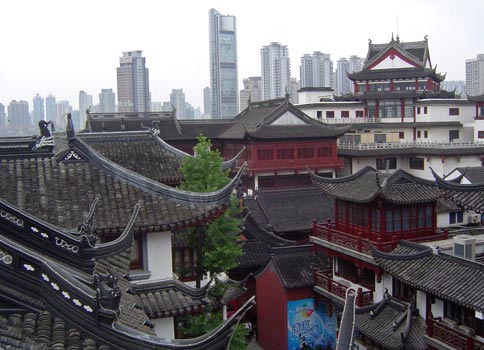 Rooftops of Old Shanghai and Modern Shanghai Office Towers.
Rooftops of Old Shanghai and Modern Shanghai Office Towers.
For geography central Shanghai is divided into Pudong, East of the Huangpu River and Puxi, which is west of the Huangpu River. Most of the cities attractions are in Puxi which also includes the Bund. West of the Bund is the former international settlement and located in that area is Nanjing Lu, the foremost shopping district for those happy shopaholics! South of the Bund you will find Nontango with its maze of narrow back streets and alleys, the old part of Shanghai. Near to the old town is the former French quarter where you will stumble across western style restaurants and bars.
For characters of Shanghai there must be many that have left their mark but one chap in particular is someone whom you may have had no wish in bumping into. If you stepped into a time machine that took you back to the city in the 1930’s you would have heard of Du Yuesheng who was the Godfather of the Shanghai underworld. He was also known as ‘Big Ears’; but that was when he was out of ear-shot! In 1927 he led the Green Gang whose purpose was to control prostitutes, drug and protection rackets. He liked kidnaping wealthy citizens and then negotiating the ransom, always pocketing half the money as a commission. He prowled around town in a bullet proof sedan with armed bodyguards and was known as the Chinese ‘Al Capone’ In 1931 he played a part in Chiang Kaishek’s anti-communist massacre where he was ‘elected’ to the municipal council and reigned as unofficial Mayor until the Japanese invasion. Naturally after that intrusion he fled first to Chongqing and then onto Hong Kong where he died a billionaire in 1951; he sounds a charming chap!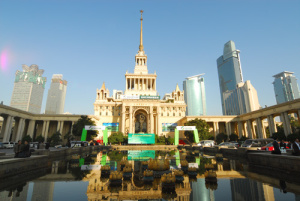
Shanghai Exhibition Centre, where Design Shanghai will take place
So our proprietor at Raffety Clocks will be in for an incredibly interesting time in China’s most chichi city. If you bump into him at Design Shanghai walk onto the stand and you will be greeted with the sonorous melodies of a musical bracket clock with automata in the arch of the dial.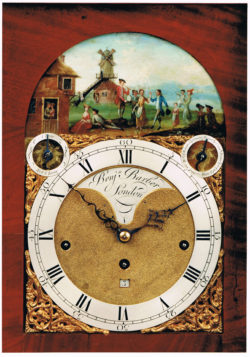
Detail of Musical Automata Bracket Clock by John Barber, circa 1770-1775. One of the clocks to be shown at Design Shanghai. Raffety Ltd.
Or you may see a splendid longcase clock in gorgeous green and gold lacquer depicting figures, birds and flowers in romantic landscapes. The company has chosen a selection of clocks from the early period of ebony and walnut, to lacquered examples to compliment the Chinese taste, and mahogany to satinwood.
A Lacquered Longcase Clock by John Monkhouse, London. Circa 1760s. To be shown at Design Shanghai. Raffety Ltd.
It is a situation which is entirely new to Raffety Clocks and will hopefully be an interesting experience to all involved. So; do come along to see us if you are in the colourful city of Shanghai between February 27th to March 2nd. We can assure you; it will be fun!
Satinwood Bracket Clock by Thomas Wright, Poultry. Watchmaker to the King. Circa 1785. To be shown at Design Shanghai. Raffety Ltd.
By Stephen Wild
Design Shanghai Fair takes place February 27-March 2, 2014 at the Shanghai Exhibition Centre, Shanghai, China.
For more information on Design Shanghai visit www.designshowshanghai.com/uk/
For tickets contact Raffety Clocks

The Forbidden City, Beijing.
China must be the most amazing of places. For one thing you have Beijing and the beautiful Forbidden City. In the 18th century the Emperors of China collected clocks and at the Imperial Museum there is a whole colourful collection of musical and automata clocks on display. There is also the famous Great Wall and the Terracotta Army which can thrill and delight.
On the other side of the Chinese coin, Shanghai, the place where Mr Raffety is visiting after Beijing is a melting pot known as ‘The Pearl of the Orient’ or ‘The Paris of the East’. For those of our followers who have never been there, you may know the city in films, such as ‘Shanghai Express’, ‘Empire of the Sun’, ‘The Red Violin’ and ‘Purple Butterfly’. With a population of twenty-four million Shanghai is one of China’s largest cities. It is the country’s financial centre and has the world’s busiest container port. The city sits at the mouth of the Yangtze River in the middle of the Chinese coast.

A Magnificent Automaton Clock, with English Clock Movement, in the Forbidden City Museum, Beijing.
The name Shanghai derives from the word ‘Shang’ meaning, ‘above’ and ‘Hai’ mean’s ‘Sea’, together meaning ‘Upon-the -Sea’. The earliest settlement dates from the 11th century where there was a town with this name in the area. Historians today have concluded that during the Tang dynasty Shanghai was literally on the sea, so hence the origin of the name.

Modern Shanghai
For centuries the capital was known for its shipping, administration and for trading. Europeans were attracted to the city when it was opened for foreign trade after British victory over China in the first Opium war. In 1842 the treaty of Nanking allowed the establishment of the Shanghai International Settlement. This vibrant city flourished throughout the 19th and 20th centuries until 1949 when the communists took over, by which time the cities global influence had declined. By the 1990’s the future was looking brighter for Shanghai with reforms by Deng Xiaoping which resulted in reinvestment and redevelopment transformed the city, bringing encouragement for European investment and commerce to Shanghai.
 Old Shanghai and the Bund.
Old Shanghai and the Bund.Shanghai has the most amazing cityscape. It is almost something out of a science fiction film. For dazzling architecture you may see the huge Jinmao Tower, visit Yuguan Gardens and bazaar, Huzhou pagoda, and take a stroll around the back alley communities of Nontango. For museum culture you can look no further than Shanghai Museum of Art and History, the China Art Museum or the Shanghai Natural History Museum to name but a few. If Design Shanghai has exhausted you then take the road to Nanjing Lu which is the down town Shanghai shopping district where you will feel quite at home with all the gorgeous glossy brands that you see in the West.
 The Famous Bund in Shanghai.
The Famous Bund in Shanghai.Other than all that what else is there to do? Well, how about walks along the Bund where you can see those annoyingly fit and healthy sports fanatics do early morning Tai Chi exercises, or failing that, eat Uygur dapangi which is fried chicken and potatoes at the Afanti Restaurant at lunch time. If you are in the mood for a cocktail then have a slick martini in the Glamour Bar. If you are feeling energetic you could always enrol in a martial arts course. For a sharp bit of cutting edge fashion be daring and commission a rather snappy outfit that has been popular in Shanghai since the 1930’s. This is known as a qipao or cheongsam which is a one piece dress tailored to fit the body; this was a popular amongst the rich upper class women and today you can have one made at the Dongjiadu cloth Market. For after dark entertainment why not head to ‘Loft’ which is a converted cinema where you can drink, dine and dance the night away…
 Rooftops of Old Shanghai and Modern Shanghai Office Towers.
Rooftops of Old Shanghai and Modern Shanghai Office Towers.For geography central Shanghai is divided into Pudong, East of the Huangpu River and Puxi, which is west of the Huangpu River. Most of the cities attractions are in Puxi which also includes the Bund. West of the Bund is the former international settlement and located in that area is Nanjing Lu, the foremost shopping district for those happy shopaholics! South of the Bund you will find Nontango with its maze of narrow back streets and alleys, the old part of Shanghai. Near to the old town is the former French quarter where you will stumble across western style restaurants and bars.
For characters of Shanghai there must be many that have left their mark but one chap in particular is someone whom you may have had no wish in bumping into. If you stepped into a time machine that took you back to the city in the 1930’s you would have heard of Du Yuesheng who was the Godfather of the Shanghai underworld. He was also known as ‘Big Ears’; but that was when he was out of ear-shot! In 1927 he led the Green Gang whose purpose was to control prostitutes, drug and protection rackets. He liked kidnaping wealthy citizens and then negotiating the ransom, always pocketing half the money as a commission. He prowled around town in a bullet proof sedan with armed bodyguards and was known as the Chinese ‘Al Capone’ In 1931 he played a part in Chiang Kaishek’s anti-communist massacre where he was ‘elected’ to the municipal council and reigned as unofficial Mayor until the Japanese invasion. Naturally after that intrusion he fled first to Chongqing and then onto Hong Kong where he died a billionaire in 1951; he sounds a charming chap!

Shanghai Exhibition Centre, where Design Shanghai will take place
So our proprietor at Raffety Clocks will be in for an incredibly interesting time in China’s most chichi city. If you bump into him at Design Shanghai walk onto the stand and you will be greeted with the sonorous melodies of a musical bracket clock with automata in the arch of the dial.

Detail of Musical Automata Bracket Clock by John Barber, circa 1770-1775. One of the clocks to be shown at Design Shanghai. Raffety Ltd.
Or you may see a splendid longcase clock in gorgeous green and gold lacquer depicting figures, birds and flowers in romantic landscapes. The company has chosen a selection of clocks from the early period of ebony and walnut, to lacquered examples to compliment the Chinese taste, and mahogany to satinwood.

A Lacquered Longcase Clock by John Monkhouse, London. Circa 1760s. To be shown at Design Shanghai. Raffety Ltd.
It is a situation which is entirely new to Raffety Clocks and will hopefully be an interesting experience to all involved. So; do come along to see us if you are in the colourful city of Shanghai between February 27th to March 2nd. We can assure you; it will be fun!

Satinwood Bracket Clock by Thomas Wright, Poultry. Watchmaker to the King. Circa 1785. To be shown at Design Shanghai. Raffety Ltd.
By Stephen Wild
Design Shanghai Fair takes place February 27-March 2, 2014 at the Shanghai Exhibition Centre, Shanghai, China.
For more information on Design Shanghai visit www.designshowshanghai.com/uk/
For tickets contact Raffety Clocks

